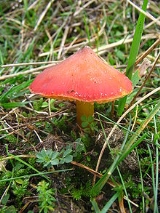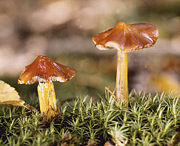
Hygrocybe conica
Encyclopedia
Hygrocybe conica, commonly known as the witch's hat, conical wax cap or conical slimy cap, is a colourful member of the genus Hygrocybe
(the waxcaps), found across northern Europe
and North America
. Originally described as Hygrophorus conicus, it may actually be a complex of closely related and similar species.
 The witch's hat is a small mushroom, with a convex to conical yellow-orange to red cap 2 to 5 cm (¾-2 inches) in diameter, though very occasionally larger specimens up to 8 or 9 cm (3½ in) diameter are found. Bruises black.
The witch's hat is a small mushroom, with a convex to conical yellow-orange to red cap 2 to 5 cm (¾-2 inches) in diameter, though very occasionally larger specimens up to 8 or 9 cm (3½ in) diameter are found. Bruises black.
, as well as Australia
and New Zealand
, being found in summer and autumn. It is likely that what is currently termed Hygrocybe conica is actually a complex of closely related species, some of which are suspected of being poisonous.
Though Hygrocybe conica does occur in Australia, principally near urban areas, many collections originally assigned to this species are actually the similar Hygrocybe astatogala.
in the early part of the 20th century which was allegedly from this species.
Hygrocybe
Hygrocybe is a genus of agarics in the family Hygrophoraceae. Called "waxcaps" in English , basidiocarps are often brightly coloured and have waxy to slimy caps, white spores, and smooth, ringless stems...
(the waxcaps), found across northern Europe
Europe
Europe is, by convention, one of the world's seven continents. Comprising the westernmost peninsula of Eurasia, Europe is generally 'divided' from Asia to its east by the watershed divides of the Ural and Caucasus Mountains, the Ural River, the Caspian and Black Seas, and the waterways connecting...
and North America
North America
North America is a continent wholly within the Northern Hemisphere and almost wholly within the Western Hemisphere. It is also considered a northern subcontinent of the Americas...
. Originally described as Hygrophorus conicus, it may actually be a complex of closely related and similar species.
Description

Distribution and habitat
The witch's hat is widely distributed in grasslands and conifer woodlands across North America, Europe and AsiaAsia
Asia is the world's largest and most populous continent, located primarily in the eastern and northern hemispheres. It covers 8.7% of the Earth's total surface area and with approximately 3.879 billion people, it hosts 60% of the world's current human population...
, as well as Australia
Australia
Australia , officially the Commonwealth of Australia, is a country in the Southern Hemisphere comprising the mainland of the Australian continent, the island of Tasmania, and numerous smaller islands in the Indian and Pacific Oceans. It is the world's sixth-largest country by total area...
and New Zealand
New Zealand
New Zealand is an island country in the south-western Pacific Ocean comprising two main landmasses and numerous smaller islands. The country is situated some east of Australia across the Tasman Sea, and roughly south of the Pacific island nations of New Caledonia, Fiji, and Tonga...
, being found in summer and autumn. It is likely that what is currently termed Hygrocybe conica is actually a complex of closely related species, some of which are suspected of being poisonous.
Though Hygrocybe conica does occur in Australia, principally near urban areas, many collections originally assigned to this species are actually the similar Hygrocybe astatogala.
Edibility
The edibility or otherwise of Hygrocybe conica is unclear. Its small size and being coated in a sticky substance render it of limited palatability anyway, however there is a report of poisoning from ChinaChina
Chinese civilization may refer to:* China for more general discussion of the country.* Chinese culture* Greater China, the transnational community of ethnic Chinese.* History of China* Sinosphere, the area historically affected by Chinese culture...
in the early part of the 20th century which was allegedly from this species.
External links
- "Fungus of the Month for October 2001: Hygrocybe conica, the witch's hat mushroom" by Tom Volk, TomVolkFungi.net.
- “Hygrocybe conica” by Robert Sasata, Healing-Mushrooms.net, September, 2007.

